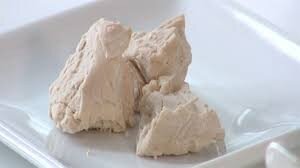This is a recipe from "Mary & Vincent Price's Come Into The Kitchen Cook Book," which contains recipes they collected from different time periods of American history.
This one dates from the American Civil War era (1860's), and by the title, maybe it was their version of "freedom fries."
I posted about this in the Today's Bread topic, it didn't come out exactly as I envisioned, and the recipe is posted at morning glory's request.
FEDERAL BREAD
Makes 2 loaves
INGREDIENTS
1 pint of light cream
1/4-cup of butter or margarine
1 tsp of salt
2 packages of active dry yeast
1/2-cup of warm water
4-1/2 to 5 cups of flour
2 eggs, beaten
DIRECTIONS
Scald the cream, add the butter and salt, cool. Soften the yeast in yarn water. Make a well in the center of the flour in a bowl, add the eggs, cream, and yeast. Stir smooth and beat 1 minute. Divide the batter between two 8" x 4-1/2" x 3" greased loaf pans. Set the pans, covered, in a warm place to rise until doubled. Bake at 375F for 30 minutes or until the loaves are golden. Remove from pans and cool.
I used an equal mix of AP flour and white whole wheat flour. The dough was very wet, just slightly heavier than a cake batter, and after the single rise, was quite fragile and filled with holes. In the oven, it sprang, then collapsed a bit. I also didn't bother scalding the cream, just warmed it in the microwave.
The appearance isn't that great, but the taste is good - somewhere between a normal sandwich bread and a moist muffin. This would be excellent bread with a soup, not so good as a sandwich bread.
This one dates from the American Civil War era (1860's), and by the title, maybe it was their version of "freedom fries."

I posted about this in the Today's Bread topic, it didn't come out exactly as I envisioned, and the recipe is posted at morning glory's request.
FEDERAL BREAD
Makes 2 loaves
INGREDIENTS
1 pint of light cream
1/4-cup of butter or margarine
1 tsp of salt
2 packages of active dry yeast
1/2-cup of warm water
4-1/2 to 5 cups of flour
2 eggs, beaten
DIRECTIONS
Scald the cream, add the butter and salt, cool. Soften the yeast in yarn water. Make a well in the center of the flour in a bowl, add the eggs, cream, and yeast. Stir smooth and beat 1 minute. Divide the batter between two 8" x 4-1/2" x 3" greased loaf pans. Set the pans, covered, in a warm place to rise until doubled. Bake at 375F for 30 minutes or until the loaves are golden. Remove from pans and cool.
I used an equal mix of AP flour and white whole wheat flour. The dough was very wet, just slightly heavier than a cake batter, and after the single rise, was quite fragile and filled with holes. In the oven, it sprang, then collapsed a bit. I also didn't bother scalding the cream, just warmed it in the microwave.
The appearance isn't that great, but the taste is good - somewhere between a normal sandwich bread and a moist muffin. This would be excellent bread with a soup, not so good as a sandwich bread.



